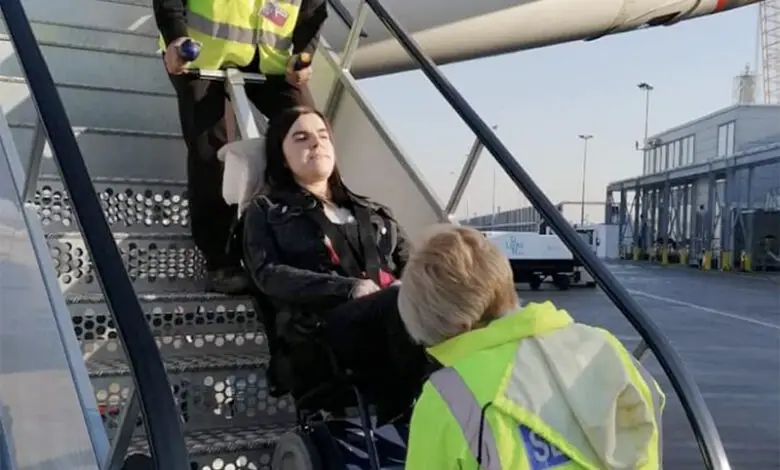
Flying as a wheelchair user: it’s time for airlines to listen and make changes
UPDATED 2 MAY 2023: Be part of the new #RightsOnFlights campaign to improve travel on aircraft for disabled people.
Flying is supposed to be an exciting experience, travelling to your favourite locations and taking a relaxing holiday in a beautiful resort. However, for wheelchair users, this experience can be quite the opposite and sometimes distressing.
At present, wheelchair users can not remain in their wheelchairs on flights and are instead manhandled into a standard, non-supportive, aeroplane seat. This can, in many cases, cause injury and anxiety for disabled customers.
AbleMove, who created the EasyTravelseat, along with Flying Disabled, undertook a survey of 336 wheelchair users to help understand the significant concerns wheelchair customers have when travelling by air, to hopefully influence the legislation going forward.
Having asked both powered (65%) and manual wheelchair (35%) users in the US, UK, Europe, Asia and Africa, the biggest concerns were:
- wheelchairs being lost or damaged
- toileting at airports and onboard the aircraft
- transferring on and off the aircraft
- seating in the cabin
- boarding and disembarking processes
- carriage of medical equipment.
One in four wheelchair customers rates their overall experience flying by air as good, very good, or extremely good. But 43% of wheelchair customers said they are no longer choosing to fly (unrelated to Covid).
We believe that everyone should have access to air travel, and we welcome the significant improvements in accessibility made by UK airlines and airports in recent years. – Sir Stephen Hillier, Chair of the UK Civil Aviation Authority.
The findings support the urgent need for a globally harmonised standard that ensures the same level of service at every airline and airport. Whilst providing guarantees wheelchairs will not be lost or damaged, improve timing and dignity when boarding and disembarking.
There is also a real need for a solution that enables wheelchairs in the cabin, and accessible toilets so that wheelchair customers can explore the world like everybody else who take it for granted.
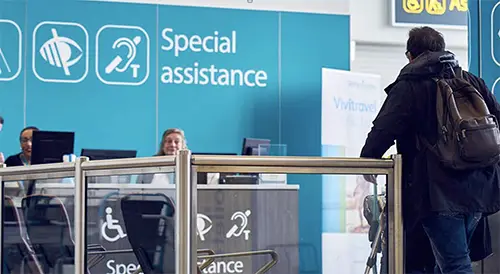
Wheelchair customers (WCHC) are one of the smallest categories of PRMs (passengers with reduced mobility) in the aviation industry.
Josh Wintersgill, the founder of AbleMove says:
“PRM volume is equivalent to 1% to 2% of overall passenger numbers globally. For example, in the UK during 2018 there were roughly 3.2m PRM requests. WCHC passengers make up 5 to 7% of total PRM requests. In the UK that equated to between 160k and 224k requests in 2018.
The perception from the industry around the true value of wheelchair passengers is misconstrued and maybe why advancements to eradicate some of the biggest problems faced by wheelchair passengers remain slow.”
These findings evidence the hassle, sacrifices and humility that goes into travelling by air for wheelchair customers.
One customer said: “Flying as a wheelchair user is completely humiliating and current procedures are a deterrent to fly at all!”
How many wheelchair users fly
Initially, respondents were asked to identify whether they:
- had never flown
- have flown but since stopped
- continue to fly (Covid restrictions allowing).
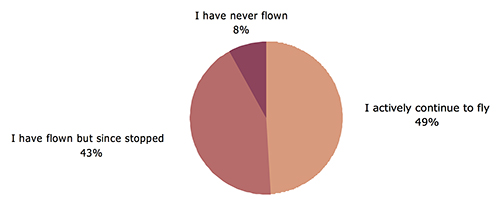
To gain greater insight into the decisions behind why wheelchair customers have never flown, or have since stopped, we asked what the single most important reason was and if they had more than one.
Wheelchair customers who have never flown
44% of those who have never flown said the most important reason why is due to the fear of losing or getting their wheelchair damaged.
Asking what would encourage them to fly, the majority stated: “Being able to stay in my wheelchair on board the aircraft”.
One respondent would be encouraged to fly: “If I had a 100% assurance that I would have my chair intact and at the correct destination then I’d be more comfortable.”

Wheelchair customers who have flown but since stopped
Out of 43% of people who have flown but have since stopped, the single biggest reason was personal injury or having had bad experiences when it came to transferring on and off the aircraft, equating to 33%.
Respondents stated multiple reasons why they have stopped flying:
- 56% not being able to use the restroom.
- 49% fear their wheelchair being lost or damaged.
- 46% have stopped due to personal injury or bad experiences when being transferred.
- 39% have stopped due to deterioration in mobility.
- 52% of wheelchair customers who have since stopped flying use to fly between one to five times a year.
These passengers were also asked what would encourage them to get back flying again.
The majority of respondents said they would need to be able to remain in their wheelchair as this helps to avoid their chair being lost or damaged and removes the need for transferring to aisle chairs.
Wheelchair customers who actively continue to fly
With those who actively continue to fly, there is a similar correlation with 55% saying the biggest single cause of concern when flying was due to the fear of their wheelchair being damaged or lost.
We also asked how often they fly, with the majority doing so one to two times a year, followed by a handful of times.
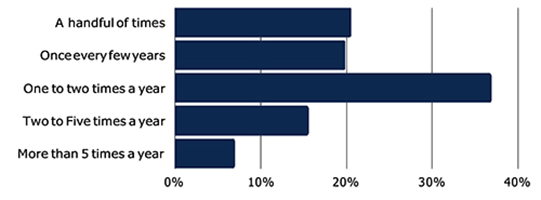
Wheelchair damage when flying
60% of the people we spoke to have had their wheelchair damaged when flying.
One said: “I can fly without being seated in my chair, but the stress of knowing the chair is going to be lost or damaged is very high. I arrived in Turkey with no wheelchair at all. It had not been put on the flight.”

Remaining in your wheelchair for short and long haul flights
Respondents were asked whether if they could remain within their wheelchair, would they fly more frequently than they currently do for short and long-haul flights.
For both types of flights, most people (76% for short-haul and 68% for long) said they would.

Respondents were asked to identify what types of flights were and were not possible for them to manage without being in their wheelchairs.
People most readily (60%) said they could only manage a short-haul of 30 minutes to three hours, followed by mid-haul (37%) at three to seven hours.
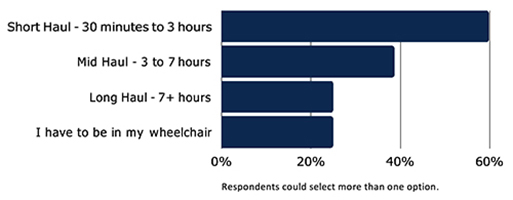
With toileting being a critical factor for wheelchair customers, it was also important to understand how long somebody in a wheelchair could manage a flight without needing access to the toilet.
Again, 30 minutes to three hours is what the highest proportion of people selected (more than half).

Because of this, many wheelchair users have to dehydrate or starve themselves of food in order to fly.
A staggering 62% of wheelchair customers we spoke to dehydrate or starve themselves in order to fly.
This process can start at least 24 hours prior to flying to ensure they will not need the toilet and can cause significant detriment to their health.
One survey respondent said: “To be able to remain in my own wheelchair and that restroom facilities be accessible onboard so my body does not need to take such a toll being dehydrated.”
Wheelchair passengers should have access to toilet facilities like any other passenger, particularly onboard the aircraft.
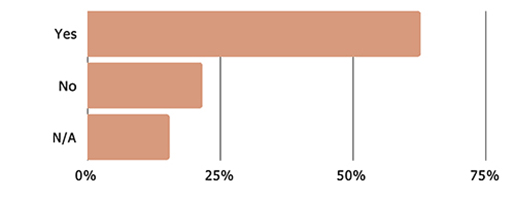
Significant advancements need to be made to toilet facilities on long haul flights. And if wheelchairs were allowed in the cabin, could they be released from a tie-down to get to an accessible toilet?
A question also remains around whether it is possible to get a Changing Places-style toilet (the type of toilet these customers require and define as accessible) into a twin-aisle aircraft, let alone a single-aisle aircraft?
This raises significant concern, as single-aisle aircraft are becoming more commonplace for mid and long-haul flights.
Transferring to and from the aircraft
With transferring being such a significant cause of concern for customers in these findings, it is critical to understand whether wheelchair customers actually know if any equipment exists that can be used to safely transfer them to and from their wheelchair and the aircraft.
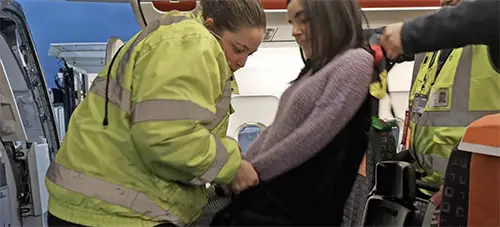
With just six companies across the globe providing suitable equipment, 53% didn’t know transferring equipment existed, 24% could self-transfer with only 23% reporting having used transferring equipment.
Legislation on lifting on and off the aircraft
Wheelchair customers have identified transferring and injury is of huge concern for them. It does raise a question, why is it that there is no legislation at a minimum that enforces the use of equipment to help reduce the impact on transferring?
Respondents were asked how strongly they agree that legislation should be changed to ensure people who require being lifted on and off an aircraft are done so with an appropriate piece of transferring equipment. 71% strongly or moderately agree that it should be changed.
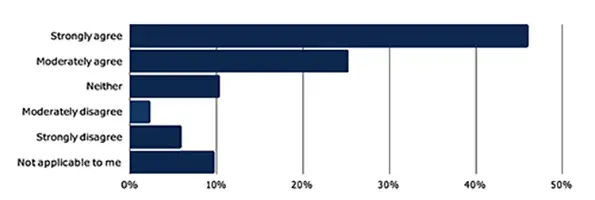
Aisle chair safety
The other element of being transferred to and from the aircraft involves using an aisle chair. Aisle chairs are used to take the customer from the cabin door to their seat.
Aisle chairs have been designed purely to fit the aircraft rather than designed to fit the needs of the person having to sit in it.
To understand how inadequate these aisle chairs are, respondents were asked how safe they felt when using one.

Only 2% of wheelchair customers felt very safe, with 58% feeling moderately or very unsafe. One respondent said: “As soon as you go to the transfer chair and onto the aeroplane you immediately feel like you don’t belong if you are disabled.
Nothing is made for us and everything is so difficult too, and it is very disheartening because I would love to travel more if it wasn’t so hard.”
Boarding before other passengers
Another challenge wheelchair customers face, is when an airline has already commenced boarding of other passengers. For many (69%), this leads to overwhelming anxiety and paranoia. People can feel like a puppet getting dragged onto an aircraft whilst being watched by lots of people is humiliating.
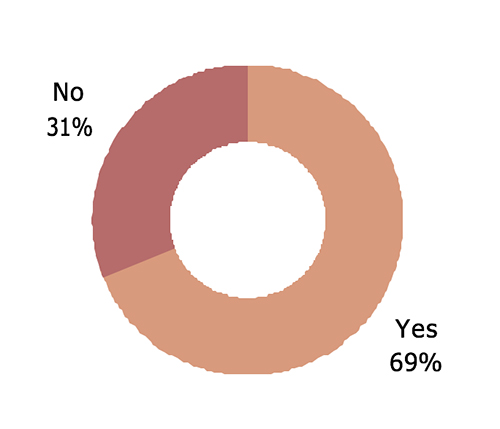
One said: “It was the most awful experience, I was transferred through a full flight, getting stuck in the aisle, being watched by all passengers, was taken to my seat which was right at the back of the flight! The staff did not know how to manage the chair or to help me out into a seat.”
Another echoed this experience: “I was made to wait until all the passengers were on and then seen to – the chair did not arrive on time, I was the last to be taken off, after a seven-hour flight it was another 45 minutes before I got off. I was desperate for the washroom. It was the most humiliating and stressful experience of my life.”
Special assistance when being supported on and off the aircraft
Another area where passengers face significant trepidation is with the attitude of staff and appropriate training.
Whilst training on general disability, diversity and inclusion has come on at phenomenal rates, it still appears that wheelchair passengers are being significantly let down.
One passenger commented saying:
I often feel like an inconvenience to the staff. Sometimes staff rush without taking into consideration my concern and safety for proper transfer off the plane.
When surveys are conducted generally to get PRM feedback, often wheelchair passengers views are lost in translation purely because their responses are significantly outweighed to a greater volume of other PRMs.
At the backend of 2020, the UK CAA (Civil Aviation Authority) released its rankings of special assistance service ratings for UK airports with 15 airports rated as very good, 13 as good, three as needs improvement and 0 as poor.
It found that 90% of passengers who responded to a survey at Glasgow and Bristol on the standard of assistance rated the service as good or excellent at both airports.
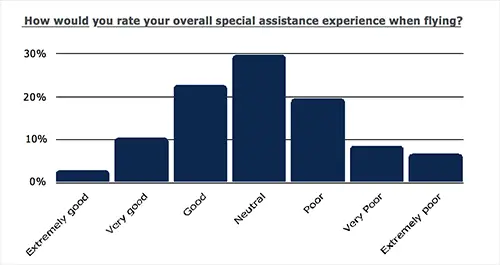
However, when asking wheelchair passengers about their general experience of special assistance when supporting them on and off the aircraft, it paints a completely different picture.
Two in three people rate their experience as neutral, poor, very poor or extremely poor.
Overall experience when flying by air
One in four rated their overall experience as good, very good, and extremely good. The other three in four people rated it as ‘neither good nor poor, poor, very poor or extremely poor.
The most commonly occurring words across all responses in the survey from wheelchair customers.
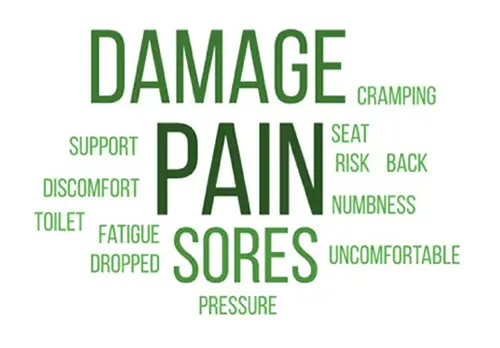
Change is needed for wheelchair users
The findings point to a clear solution, ‘wheelchair in the cabin’. That gives wheelchair customers the safety, dignity and comfort they are entitled to.
Allowing wheelchairs in the cabin will get more wheelchair customers in the sky, flying more frequently in groups of more than two, contributing to significant growth in tickets sales.
It will remove the need for specialist equipment to board passengers, prevent the logistical challenges of putting wheelchairs into the hold and improve boarding and disembarking.
Whilst various organisations such as All Wheels Up, Wheelchair Travel and Flying Disabled (to name a few) work to make ‘wheelchair in the cabin’ a reality for millions of wheelchair users around the globe.
There is a significant amount of work in the immediate future the industry can address to help improve the experience of these passengers.
A superb start would be:
- A globally harmonised standard that ensures the same level of service at every airline and airport across the globe.
- Provide wheelchair passengers guarantees their wheelchairs will not be lost or damaged.
- Improve timing and dignity when boarding wheelchair passengers.
- Increase dialogue and innovation with the industry about wheelchair in the cabin and accessible.
Of course, this requires further investment and Covid-19 will impact this. For now, the fear and humility of flying amongst the WCHC community remain, preventing them from being able to explore the world like everybody else who take it for granted.
“In the US, each airline has its own process, requirements, paperwork, etc. It would be nice if there was more uniformity over the entire process. Current guidelines allow for too much deviation.”
By Josh Wintersgill and Christopher Wood
More on Disability Horizons…